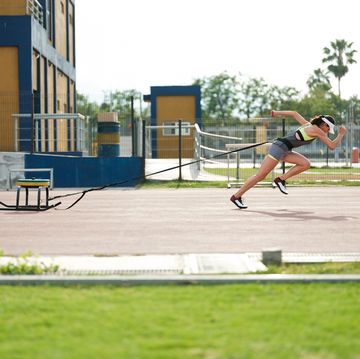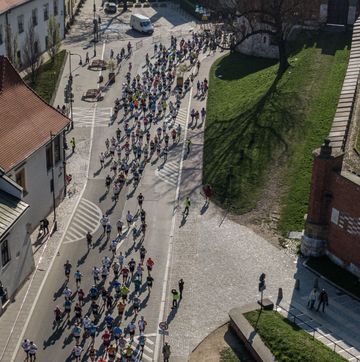You are guilty of enjoying your running too much and ignoring the early warning signs of an injury. Your sentence is eight weeks of no running. You’re injured, and it’s a big one. The doctor says absolutely no running for two months, and then a gradual return.
This is the news Scott Douglas received last fall when he was diagnosed with a stress fracture of the tibia. Scott sent me an SOS by e-mail. He asked for a crosstraining plan that would keep him fit and preserve his sanity while his shin recovered. Having endured similar trials myself (and vicariously through my wife), I knew Scott would be frustrated and worried that he would rapidly lose fitness. And his usual form of stress relief, running, would be absent. I needed to design a training schedule that would be hard enough to maintain fitness for a well-trained runner, but not so hard that Scott would become discouraged and quit before the injury was fully healed.
Most of the benefits of training are reversible. Your cardiovascular fitness, for example, decreases measurably after two to three weeks without training. Studies have shown, however, that with reduced training you can maintain your fitness at almost the same level for several months. The intensity and specificity of crosstraining workouts are most important in determining how much fitness you lose when you take time off from running. You must do some training above 70% of VO2 max in order to maintain your aerobic fitness and racing performances. And of course, you need to find a method of crosstraining that will allow your injury to heal.
The best way to crosstrain
Depending on your specific injury, you may be able to cycle, row or use a cross-country skiing simulator. If you can do these activities without interfering with your recovery, then by all means include them in your crosstraining program. Unfortunately, however, these types of exercise aggravate a number of running injuries. Scott could not do any of them without causing pain to his injured tibia.
One thing Scott could do without pain or aggravation of his injury was run in deep water. Deep-water running is an activity that can be done with most running injuries. Running in the water while wearing a flotation vest provides an excellent training stimulus and more closely simulates land running than most other crosstraining options. Deep-water running is a total-body exercise that works your legs, trunk and arms, and positively stresses your cardiovascular system.
Several studies have verified that deep-water running can be used by runners to maintain fitness. In one study, investigators from Florida State University coerced a group of trained male runners to run in the water while another group continued regular training. The runners were tested for VO2 max, lactate threshold and running economy before and after six weeks of training.
The water-running group fully maintained aerobic fitness over the six weeks. Similarly, a study by Ed Eyestone (yes, that Ed Eyestone) and colleagues at Brigham Young University found no change in two-mile-run time after runners trained in the water exclusively for six weeks.
Additional support for the fitness benefits of water running is provided by a study from the exercise physiology lab at the University of Toledo, in which trained runners ran in the water five or six days per week for four weeks. These runners had no change in 5K performance time, VO2 max, lactate threshold or running economy after four weeks of water running. Thus, there seems to be very little question that water running is an effective way for runners to stay fit.
Water-running technique
Proper technique for water running is an area of some debate. Some coaches insist that you try to simulate land-running form as closely as possible. Although that is a nice ideal, I believe that the most important consideration is to maintain your training intensity to the degree possible, and if your form isn’t perfect, so be it. Regardless of your running form, your stride rate will be slower when water running because of the increased resistance of moving your legs through water. If you try to simulate land running too closely, your stride rate will be even slower. For that reason, don’t worry if your leg isn’t brought behind the body to the same degree as in land running. Find a happy compromise with decent form and a reasonable rate of leg turnover.
Some athletes move forward while running in the water and actually do laps during their workouts. Whether you move forward or remain relatively still depends on subtle differences in body position. I recommend a relatively upright posture during water-running workouts. This will work your trunk muscles and result in only a slight tendency to move forward through the water.
DOWNLOAD A PDF OF THE PLAN HERE
Gauging your effort
You will not be able to achieve as high a heart rate running in the water as running on land. A study from the Karolinska Institute in Stockholm found that heart rate is eight to 11 beats per minute slower for the same oxygen uptake when running in the water compared to land running. This study also found average maximal heart rate to be 16 beats per minute lower during all-out water running compared to running on land. Lower heart rates during water running are primarily due to the pressure of water on the body, which makes more blood return to the heart so more blood is pumped with each contraction.
A useful rule of thumb is that heart rate during water running is about 10% lower than during land running. If you get your heart rate up to 140 beats per minute in the water, that is roughly equal to 154 beats per minute during normal running. The temperature of the water affects your heart rate; the heart will beat more slowly in cool water and more rapidly in warm water. Two studies have found that women have slightly lower heart rates and oxygen consumption levels than men during deep-water running. This is thought to be due to women’s generally higher body-fat percentage and resultant greater buoyancy than men.
The Karolinska Institute study found that perceived exertion is higher during water running for a given heart rate or level of oxygen consumption. So, in attempting to get a beneficial workout in the water, you will feel that you’re working harder than during land running. For this reason, the nine-week schedule emphasizes interval workouts in the water. If you only do steady water-running sessions your effort won’t be high enough to maintain your fitness. A study on water running by former 800-meter runner Tim Quinn, Ph.D., and colleagues at the University of New Hampshire concluded that it appears to be critical for runners to include intervals, tempo running and/or fartlek training in order to maintain fitness while water running.
Nine Weeks to Recovery
To survive a no-running routine while your injury heals, you need a schedule that provides structure and poses a challenge. With the program outlined below, you don’t have to worry about losing fitness. In fact, if you approach the program aggressively, you may come out of the water fitter than before your injury. Scott says, “I enjoyed the borderline-psychotic challenge of setting duration PRs, which peaked with a two-hour interval session on New Year’s Eve.”
This schedule is not for the faint of heart. The program includes five days of deep-water running per week for eight weeks. One day per week calls for a specific 30- to 45-minute stretching session. The seventh day calls for another form of crosstraining (if your injury will allow it) or rest. In the ninth week, you start to reintroduce land running to your schedule.When you look at the schedule, you will notice a lot of interval workouts. That’s because it is very difficult to work at a high enough intensity to maintain your fitness if all you do is steady-state water running. Interval sessions in the water give you brief breaks (both physical and mental); these allow you to work harder and obtain a superior workout. Another plus is that time passes relatively quickly while doing intervals, whereas steady water running is boring.
DOWNLOAD A PDF OF THIS PLAN HERE
MONDAYS: Sessions are repeats of 1:30 hard followed by 30 seconds of easy recovery running. The first week, you warm up, then do two sets of five intervals with a two-minute break between the two sets. At the end of your cool-down, you’ll have completed 32 minutes of water running, with 15 minutes of that at high intensity. Over the nine weeks, Monday’s workouts progress to three sets of nine reps for a total workout of 68 minutes with just over 40 minutes at high intensity.
TUESDAYS: Workouts consist of longer repeats (2:30) with 30 seconds recovery. These are tougher than Monday’s sessions because you must hold the intensity of each interval longer, while the rest remains the same. This workout is very efficient when you are pressed for time. In the ninth week, you blissfully get to go out for your first run, albeit only 10 easy minutes.
WEDNESDAYS: This workout is the toughest of the week mentally. It is the only water-running workout of the week that you do at a steady effort level. Scott and my wife both mastered this session, but I must admit I found it mentally very difficult. Former New York City Marathon winner Priscilla Welch, however, had no problem with steady water running. I recall watching the Super Bowl at a New Zealand pub a few years ago with Priscilla, her husband, Dave, Dick Quax and a few others. Shortly after the kickoff, Priscilla excused herself and headed to the adjacent pool for a workout. As the Patriots were thrashed, Priscilla kept running and running. She returned more than two hours later, her effort a testament to mental tenacity.
THURSDAYS: After three successive days in the water, you need a break. This is the perfect opportunity to do the stretching that you usually put off because of lack of time. A 30- to 45-minute session dedicated specifically to stretching will improve your flexibility and help prevent future injuries once you are back running. A yoga class is a great alternative for this workout.
FRIDAYS: It’s back to the pool for more intervals—this time a ladder. You start with 1:00 hard followed by 1:00 easy, then hold the recovery at 1:00 and increase the duration of the hard efforts, then decrease it going back down the ladder. This workout feels great on the way back down.
SATURDAYS: A mentally tough day with reps of 5:00. The first week calls for four reps of 5:00 hard with 1:00 easy between efforts, and you build up to eight reps of 5:00 hard, followed by 10 times :45 hard. The challenge is to maintain your mental focus during the 5:00 efforts. During this session, I find it helpful to keep my concentration by visualizing running repeat miles on the track. (Man, you must be hurting when you fantasize about running repeat miles!)
SUNDAYS: Do either another form of crosstraining such as cycling or rowing (if your injury will allow it) or rest. A long, vigorous walk on Sunday will give you some of the aesthetic and mental benefits of a run and will help prepare your legs for your return to land running.
Nine-week Training Schedule | |||||||
| WEEK | Monday | Tuesday | Wednesday | Thursday | Friday | Saturday | Sunday |
| 1 | 5:00 warm-up 2 sets of 5 x 1:30 hard (:30 easy recovery; 2:00 easy between sets) 5:00 cool-down Total workout: 32:00 | 5:00 warm-up 6 x 2:30 hard (:30 easy recovery) 5:00 cool-down Total workout: 28:00 | 5:00 warm-up 5:00 stretching 30:00 steady | 30:00 to 45:00 flexibility | Ladder Workout #1 | 5:00 warm-up 4 x 5:00 hard (1:00 easy recovery) 5:00 cool-down Total workout: 34:00 | 30:00 alternate crosstraining or rest |
| 2 | 5:00 warm-up 2 sets of 6 x 1:30 hard (:30 easy recovery; 2:00 easy between sets) 5:00 cool-down Total workout: 36:00 | 5:00 warm-up 7 x 2:30 hard (:30 easy recovery) 5:00 cool-down Total workout: 31:00 | 5:00 warm-up 5:00 stretching 35:00 steady | 30:00 to 45:00 flexibility | Ladder Workout #1 | 5:00 warm-up 5 x 5:00 hard (1:00 easy recovery) 5:00 cool-down Total workout: 40:00 | 35:00 alternate crosstraining or rest |
| 3 | 5:00 warm-up 2 sets of 7 x 1:30 hard (:30 easy recovery; 2:00 easy between sets) 5:00 cool-down Total workout: 40:00 | 5:00 warm-up 8 x 2:30 hard (:30 easy recovery) 5:00 cool-down Total workout: 34:00 | 5:00 warm-up 5:00 stretching 40:00 steady | 30:00 to 45:00 flexibility | Ladder Workout #1 Total workout: 32:00 | 5:00 warm-up 6 x 5:00 hard (1:00 easy recovery) 5:00 cool-down Total workout: 46:00 | 40:00 alternate crosstraining or rest |
| 4 | 5:00 warm-up 2 sets of 8 x 1:30 hard (:30 easy recovery; 2:00 easy between sets) 5:00 cool-down Total workout: 44:00 | 5:00 warm-up 9 x 2:30 hard (:30 easy recovery) 5:00 cool-down Total workout: 37:00 | 5:00 warm-up 5:00 stretching 45:00 steady | 30:00 to 45:00 flexibility | Ladder Workout #2 Total workout: 37:00 | 5:00 warm-up 7 x 5:00 hard (1:00 easy recovery) 5:00 cool-down Total workout: 52:00 | 45:00 alternate crosstraining or rest |
| 5 | 5:00 warm-up 2 sets of 9 x 1:30 hard (:30 easy recovery; 2:00 easy between sets) 5:00 cool-down Total workout: 48:00 | 5:00 warm-up 2 sets of 5 x 2:30 hard (:30 easy recovery; 2:00 easy between sets) 5:00 cool-down Total workout: 42:00 | 5:00 warm-up 5:00 stretching 50:00 steady | 30:00 to 45:00 flexibility | Ladder Workout #2 Total workout: 37:00 | 5:00 warm-up 8 x 5:00 hard (1:00 easy recovery) 5:00 cool-down Total workout: 58:00 | 50:00 alternate crosstraining or rest |
| 6 | 5:00 warm-up 2 sets of 10 x 1:30 hard (:30 easy recovery; 2:00 easy between sets) 5:00 cool-down Total workout: 52:00 | 5:00 warm-up 1 set of 6 x 2:30 hard 1 set of 5 x 2:30 hard (:30 easy recovery; 2:00 easy between sets) 5:00 cool-down Total workout: 45:00 | 5:00 warm-up 5:00 stretching 55:00 steady | 30:00 to 45:00 flexibility | Ladder Workout #2 Total workout: 37:00 | 5:00 warm-up 8 x 5:00 hard (1:00 easy recovery) 5 x :45 hard (:15 easy recovery) 5:00 cool-down Total workout: 63:00 | 55:00 alternate crosstraining or rest |
| 7 | 5:00 warm-up 3 sets of 7 x 1:30 hard (:30 easy recovery; 2:00 easy between sets) 5:00 cool-down Total workout: 56:00 | 5:00 warm-up 2 sets of 6 x 2:30 hard (:30 easy recovery; 2:00 easy between sets) 5:00 cool-down Total workout: 48:00 | 5:00 warm-up 5:00 stretching 60:00 steady | 30:00 to 45:00 flexibility | Ladder Workout #3 Total workout: 43:00 | 5:00 warm-up 8 x 5:00 hard (1:00 easy recovery) 10 x :45 hard (:15 easy recovery) 5:00 cool-down Total workout: 68:00 | 60:00 alternate crosstraining or rest |
| 8 | 5:00 warm-up 3 sets of 8 x 1:30 hard (:30 easy recovery; 2:00 easy between sets) 5:00 cool-down Total workout: 62:00 | 5:00 warm-up 2 sets of 6 x 2:30 hard (:30 easy recovery; 2:00 easy between sets) 5:00 cool-down Total workout: 48:00 | 5:00 warm-up 5:00 stretching 65:00 steady | 30:00 to 45:00 flexibility | Ladder Workout #3 Total workout: 43:00 | 5:00 warm-up 8 x 5:00 hard (1:00 easy recovery) 10 x :45 hard (:15 easy recovery) 5:00 cool-down Total workout: 68:00 | 65:00 alternate crosstraining or rest |
| 9 | 5:00 warm-up 3 sets of 9 x 1:30 hard (:30 easy recovery; 2:00 easy between sets) 5:00 cool-down Total workout: 68:00 | Run 10:00 on soft surface | 5:00 warm-up 5:00 stretching 70:00 steady | Run 10:00 on soft surface 30:00 to 45:00 flexibility | Ladder Workout #3 Total workout: 43:00 | Run 10:00 on soft surface | 70:00 alternate crosstraining or rest |
Ladder Workout #1:
5:00 warm-up.
Run 1:00 hard, 1:00 easy, 2:00 hard, 1:00 easy, 3:00 hard, 1:00 easy, 400 hard, 1:00 easy, 3:00 hard, 1:00 easy, 2:00 hard, 1:00 easy, 1:00 hard.
5:00 cool-down.
Ladder Workout #2:
5:00 warm-up.
1:00 hard, 1:00 easy, 2:00 hard, 1:00 easy, 3:00 hard, 1:00 easy, 400 hard, 1:00 easy, 4:00 hard, 1:00 easy, 3:00 hard, 1:00 easy, 2:00 hard, 1:00 easy, 1:00 hard.
5:00 cool-down
Ladder Workout #3:
5:00 warm-up.
1:00 hard, 1:00 easy, 2:00 hard, 1:00 easy, 3:00 hard, 1:00 easy, 400 hard, 1:00 easy, 5:00 hard, 1:00 easy, 4:00 hard, 1:00 easy, 3:00 hard, 1:00 easy, 2:00 hard, 1:00 easy, 1:00 hard.
5:00 cool-down.












